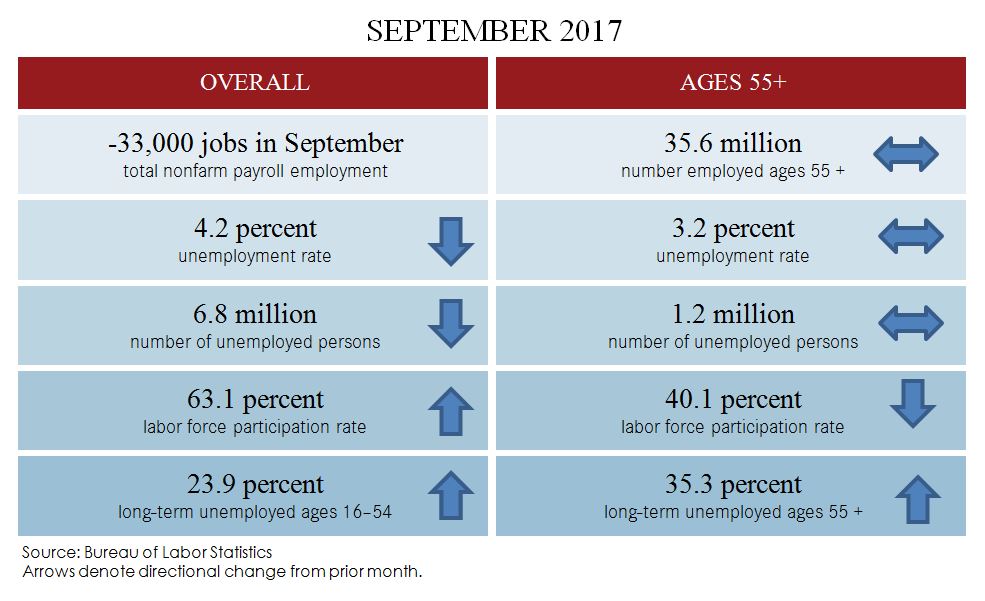AARP Hearing Center
Economy loses 33,000 jobs in September
By Jennifer Schramm, October 6, 2017 05:25 PM

Employment overview
The economy lost 33,000 jobs in September largely reflecting the impact of hurricanes Harvey and Irma. Despite the overall job loss, the labor force participation rate for those ages 55 and older decreased only slightly to 40.1 percent. The Bureau of Labor Statistics’ (BLS) September Employment Situation report showed the overall labor force participation rate edged up slightly to 63.1 percent. The unemployment rate declined to 4.2 percent with 6.8 million persons remaining unemployed. Much of the impact of the hurricanes was seen in the food services sector, which lost 105,000 jobs. Meanwhile, jobs were added in health care, transportation, and warehousing. The unemployment rate for those ages 55+ was unchanged from August (3.2 percent), but the percentage of job seekers ages 55+ who are long-term unemployed (i.e., looking for 27 or more weeks) rose from 30.5 percent to 35.3 percent.
Spotlight: Labor Market Experiences of Americans at Age 50
Turning to more long-term trends, the BLS recently released new findings from an ongoing longitudinal study of Americans born between 1957 and 1964, the tail end of the baby boomer generation. The National Longitudinal Survey of Youth 1979 is a survey of 9,964 men and women who were ages 14 to 22 in 1979 when the study first began. Participants were most recently interviewed in 2014-2015. The recently released findings track the number of jobs, labor market experience, and earnings growth of this age cohort.
Interestingly, the average annual percentage growth in inflation-adjusted hourly earnings was highest for this cohort during their late teens and early twenties. This means that their earnings increased most rapidly while they were young and just at the beginning of their careers. As a cohort, they never again replicated this rate of earnings growth over the course of their career life span, reflecting some of the larger economic trends over the ensuing decades of their lives. Earnings growth rates tended to be higher for college graduates compared with workers with less education.
Individuals without a high school diploma had lower percentages of weeks in employment compared with individuals with higher levels of education. Men were employed a greater percentage of weeks than women (84 percent of weeks for men versus 71 percent of weeks for women). But the percentage of weeks of employment grew for women from 63 percent in the 18 to 24 age category to 76 percent in the 35 to 44 age group. Overall this group of baby boomers were employed on average 78 percent of the weeks from age 18 to age 50.
This group of baby boomers held an average of 11.9 jobs from the ages of 18 to 50, spanning from five jobs while ages 18 to 24 down to 4.5 jobs from ages 25 to 34, to 2.9 jobs from ages 35 to 44, and to 1.7 jobs from ages 45 to 50. Older workers are generally thought to have longer average job durations but the study found that at least for this youngest cohort of baby boomers, short-duration jobs continued to be common at older ages. Among jobs started during ages 35 to 44, 75 percent ended in fewer than five years.
For more details on this month’s employment numbers, check out the September Employment Data Digest, PPI’s monthly review of job trends for those ages 55 and over.
































































